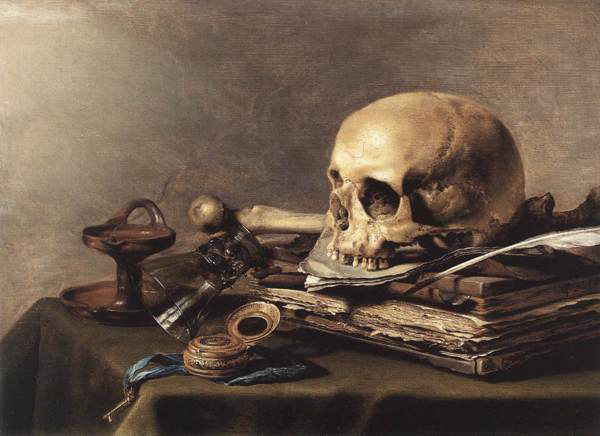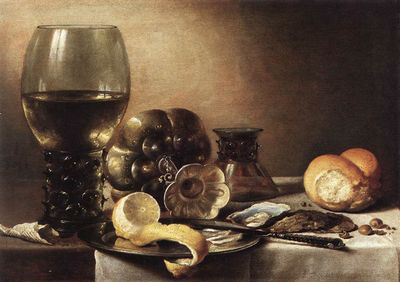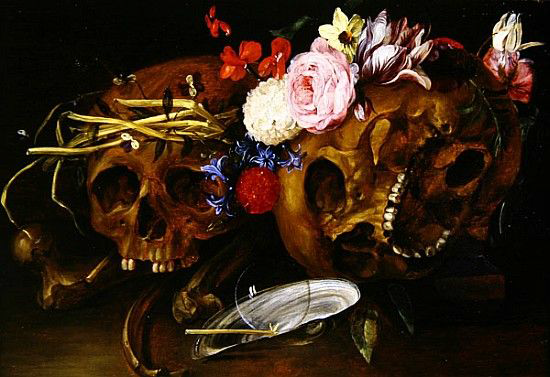Team:Paris Saclay/Project/Inspirations/Vanity
From 2014.igem.org

Contents |
Vanity: Speech about the place of humans in the universe
History
The Dutch golden age painting
Took place during the XVII century. By this time, the united-provinces were the most prosperous nation of Europe due to their strong economy, art and sciences dynamics. Although the Dutch golden age painting is part of the baroque tradition, it can be distinguished by its own specificities such as the apparition and the development of several new kinds of pictorials.
Influences of the Reform
North of Europe was facing the protestant reform, which saw idolatry in the cult of Saints and the Virgin. Thus, some leaders of the movement, such as Jean Calvi, did not hesitate to promote the destruction of religious images that were considered to be pegan heresy. In this context, vanities replaced human representations by everyday objects that were used to support the new religious morality. Paintings of “modest” size appeared to support forms of devotion that were far from the splendor of the Catholic Church: the finitude of man, the fragility of its existence and its assets are all themes dear to this troubled time.
Antique origins of Vanity…
Often wrongly associated to a particular type of still-life, Vanity is closer to a meditation theme rather than a type of pictorials. Thus, in Greek antiquity, Vanity was studied in philosophy, literature or painting. The millenary problem of the place of humans in the universe traveled through centuries, taking the form of compositions, assays, “trompe l’oeil” or genre scenes. In terms of philosophy, Stoics developed a thorough reflexion about the fugacity of terrestrial goods. They distinguish “lent” things (life, material properties, beauty …) to those that are “given” (willingness, reason …). There is no doubt that this heritage has been transmitted by the Humanist movement during the Renaissance, and strongly inspired painting of Vanity in Europe.
… And a biblical origin
The Vanity theme also originates from an episode of the Bible (Ecclesiates), as shown in this quote: “Vanity of vanities, says Qoheleth, vanity of vanities; all is vanity”. Here, Qoheleth, son of David and king of Jerusalem, asks himself about the meaning of life. “There is no remembrance of past things; nor even for those of the future: they will not be remembered by those who will come later”. Furthermore, the Hebraic word of Vanity literally means “light vapor or ephemeral breathe”. Thus, vanities invite us to meditate about the ephemeral and vain (hence Vanity) nature of human life that faces an unavoidable death.
Pieter Claesz, Nature morte avec huitre (1633)
Huile sur bois, 38x53 cm, Staatliche Junstsammlungen, Kassel
Vanity
Vanity uses symbols (such as skulls, candles, sandglass …) to highlight the transient character of human life, together with the fragility of terrestrial goods. As we previously mentioned, vanities are part of a long Greek-Roman tradition. However, this theme has been extensively developed during the first half of the XVII century. By evoking the place of humans in the universe, artists emphasize the insignificance of human’s works in regard of God’s ones. The aim is to meditate about the fact that pleasures are useless in regard of death that awaits. From 1620 to 1630, the dominant representation of still-life remains the « monochrome breakfast ». There is a limited amount of items, positioned under a diagonal light beam in a gray atmosphere. (Pieter Claesz and Willem Claesz Heda). In the second half of the XVII century, colors became more vivid and compositions more complex. For example, this evolution can be seen in Nicolaes Van Veerenael artwork.
Nicolaes Van Veerenael, Vanité (1680)
Huile sur bois, 34x46 cm, musée des beaux arts de Caen
Presentation of the artwork
This painting was achieved in 1630 in Mauristhuis (La Haye) by a Dutch painter named Pieter Claesz (1597-1661). It represents Vanity- Still life and measures 39.5 × 56 cm (oil on canvas).
Description of the painting
We can see a table on which several distinct objects are dispatched: a book, a burnt candle, a skull, a bone (probably a femur), a pen and an inkwell. The painter used a quasi- monochromatic color palette, conferring an austere and ephemeral atmosphere to the painting, as do the smokes escaping from the candlestick. The painter offers a lateral point of view of the scene, ensuring that the spectator does not crosses the gaze of the skull. The glass is represented lying between the book and the table. The ribbon, to which a key is attached at the tip, seems to be retained on the table only by the presence of the inkwell. Finally, the pen is in equilibrium on a used parchment. All together this staging confers tension to the composition.
“By evoking the place of Humans in the universe, artists emphasize the insignificance of human’s works in regard of God’s ones.”
Analysis of the artwork
Symbolism
Typically, this painting is part of the monochrome movement of the beginning of XVII century and thus presents some distinct aspects of Vanity genre:
- bones (skull and femur) directly refer to Death and to the time that goes by,
- the candlestick and the totally burnt candle suggest that all is over,
- the glass suggests the fragility and the futility of human life,
- the book and the pen represent a vanity as they refer to knowledge that diverts humans from God.
- The inkwell, as a terrestrial good, reminds us that every property is ephemeral and vain compared to Death and the divine Word.
Composition
The way the light has been used is remarkable as while shaping objects, it also seems to indicate the spectator a “reading” direction. Indeed, we can see that most items are oriented toward the left and faces the light beam: the glass falls toward the left, the skull “looks” toward the left, the key falls toward the left and the pen tip is oriented toward the left … The painter seems to place the spectator in an observation role. We are also part of the painting as the painter link the spectator to this scene by creating a path.
Vanity theme is neither about death or life but rather about the transition from one to the other through time.
Between fascination and repulsion, vanities cultivate the art of ambivalence. Indeed, the interesting paradox of this painting genre consists in that the painting immortalizes the beauty of the world while denigrating it and underlying its fugacity.
Why vanity?
From the definition of living being to the place of Humans in the universe
As we previously mentioned, Vanity evoke the place of humans in the universe, the transience of human existence and the fragility of terrestrial goods. This reflection is linked to our effort of defining the living.
« For Descartes, there are man-made machines, and life, the machines made by God whose are, in the quote above : incomparably better arranged, and adequate to movements more admirable than is any machine of human invention.» « The definition of life by entropy is significantly later, but it occurs before the birth of the fathers of thermodynamics and evolution in organisms, Ludvig Boltzmann(1844-1906) and Charles Darwin(1809-1882), in Marie François Xavier Bichat(1771-1802). The latter, sometimes regarded as a vitalist (something Foucault refuses), consider life as mysterious principle which fight against an inert environment. He describe life by : « All the forces that fight against death ».
 "
"







